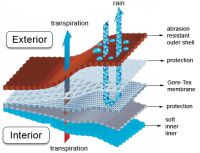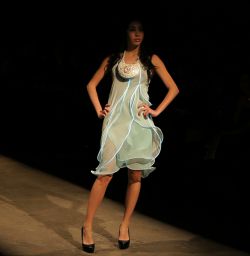Technology has advanced the functions of clothing to a new level through the creation of power-generating textiles. These materials are made of solar cell or piezoelectric fabric that will allow enough electricity to be generated to recharge a small, portable electronic device. With additional engineering and research, clothing that can recharge any portable electronic device may become the next wave in staying connected without worrying about battery life.
Introduction
Technological advances have allowed many science-fiction fantasies to become reality, with smart textiles being one of them. Smart textiles are clothing materials that are woven or embedded with advanced properties that can sense changing environment conditions or stimuli from a thermal, chemical, mechanical, electrical, or other source. There are currently many forms of smart textiles on the market, with Gore-Tex fabric being one example (Fig. 1). Gore-Tex is considered a smart textile because its laminated membrane technology restricts water and moisture to only flow in one direction. The material is also breathable, lightweight, and waterproof [1]. Engineers and researchers are currently developing smart textiles that can create enough electricity to power up an MP3 player, a cell phone, or similarly small electronic device. Two types of these power-generating textiles are solar cell fabric and piezoelectric fabric.

MayhayMate/Wikimedia Commons
Figure 1: Gore-Tex fabric is a smart textile that responds to changes in its environment, such as rain and sweat.
Solar Cell Fabric
Nowadays, most people own some sort of portable electronic device, whether it is an MP3 player, mobile phone, or camera. However, all these devices run out of power after a certain period of time. Fortunately, solar cell fabric can create enough power to charge these devices. Solar cell fabric is a smart textile embedded with photovoltaic cells that generate electricity under light exposure. Although it may seem difficult to generate enough electricity to power up an electronic device, the energy demand of portable electronic devices is low enough that clothing integrated with solar cells are able to power most electronics [2]. However, the tradeoff is a few hours spent under the sun.
Technology behind Solar Cell Fabric
Solar cell fabric and solar-powered calculators are actually similar in technology. The embedded solar cells use tiny rods of cadmium selenide, a material similarly used in computer chips, which is suspended in an organic polymer or plastic. When the cell is exposed to light, a certain portion of it is absorbed in the material [3].
The electrons flow freely through the rod and create “positive” and “negative” terminals, like a battery. By placing metal contacts on the top and bottom of the cell, the current generated can be taken and used to power a small electronic device. During lab tests, a prototype solar cell about 200 nanometers thick (around one-thousandth the thickness of a human hair) can produce just over half the voltage of a common flashlight battery [3]. Some jackets are being developed with integrated photovoltaic cells that can provide more than 40 hours of music after three hours of sunlight exposure [2].
Photovoltaic-Integrated Clothing
Photovoltaic-integrated fabric can be used for a variety of clothing and accessories. A common solar cell accessory that can currently be bought in the market is a baseball cap with a thin strip of photovoltaic metal on the top that generates power for a fan that is attached to the brim; the brighter the sun, the quicker the fan spins. Designer Andrew Schneider created a solar-powered swimsuit made by overlaying narrow strips of photovoltaic film onto a swim suit and sewing them on with conductive thread [4]. After two hours under the sun, the swimsuit was able to produce a five-volt output and when attached to a USB, indicating that it could slowly recharge an MP3 player. Schneider is currently developing a pair of solar panel-covered shorts that would be capable of generating enough charge to chill a beer [4].
Challenges of Solar Cell Fabric
Traditional solar cells are made out of silicon crystals, which are very difficult and extremely costly to make. Thus, researchers are investigating alternatives that will help lower costs while ensuring efficiency. In fact, a team of researchers at the California Institute of Technology has created a new type of flexible solar cell that uses a fraction of the expensive semiconductor material but enhances the absorption of sunlight [5]. Another aspect that requires more in-depth research is how to make the fabric less stiff and more comfortable. The solar cell fabric consists of small solar panels that are sewn on by thin conducting threads. However, this causes the fabric to be inflexible compared to woven textiles because the cells can only be bent in one direction [2].
Piezoelectric Fabric
Piezoelectric fabric is another kind of power-generating textile that is currently being engineered. This kind of smart fabric creates an electrical charge through kinetic energy generated by stretching and twisting the textile. In the future, piezoelectric textile will hopefully be able to produce enough electricity to power up a portable electronic device.
Technology behind Piezoelectric Fabric
The technology behind piezoelectric fabric is still in its infancy. However, researchers have developed this fabric through the combination of nanotechnology and a principle known as the piezoelectric effect, which is observed by generating electricity through pressure. Piezoelectric fabric has ultra-thin zinc oxide coated wires woven in one direction, while there are gold wires aligned in another direction. These wires are only 50 nanometers in diameter, which is around 1,800 times thinner than a human hair [6]. When the fabric is stretched or twisted, the two wires rub against one another and the resulting tension and pressure is converted into electricity that can power a range of portable electronic devices [6]. The nanofibers are very small, so there is no perceptible change in the comfort of the wearer when the nanofibers are woven into clothing. Currently, prototypes have demonstrated maximum energy conversion efficiencies of over 20% [7]. It is estimated that one square meter of piezoelectric fabric could produce 80 milliwatts of electricity, which is enough to recharge a portable MP3 player [6].
Piezoelectric Fashion
The concept of piezoelectric fabric can also be applied to backpacks. Engineers are currently developing backpacks that generate electricity from the friction created by the rubbing of backpack straps on shoulders [8]. The straps are made of polyvinylidene, which is a strong, flexible material similar to nylon, and will generate an electrical charge from the applied stress to power electronic devices. This kind of piezoelectric backpack is extremely beneficial to military soldiers because it is estimated that walking at 2~3 mph with a 100-pound backpack, the estimated weight carried by soldiers, could generate around 45.6 milliwatts of power [8]. The use of this kind of backpack may even lighten the load that a soldier needs to carry because electricity would be generated in place of carrying extra batteries.
Piezoelectric material can also be used to convert sound into light. Designer Diana Eng used the idea of piezoelectric effect and created piezoelectric dresses that were embroidered with LEDs, conductive silver thread, and miniature microphones [9]. The patterns on the dresses would light up when the dresses received sound waves (Fig. 2). These types of innovative dresses would be extremely popular at clubs and concerts because the pattern on the clothing will light up to beat of the music.

Wikimedia Commons
Figure 2: Designer Diana Eng uses the piezoelectric effect to make clothes light up using sound waves as stimuli.
Do Not Wash
Piezoelectric fabric is made out of zinc oxide-coated wires. Unfortunately, zinc oxide is sensitive to moisture [6]. Thus, the piezoelectric fabric cannot be washed. Engineers and researchers are currently searching for ways in order to make piezoelectric clothing resistant to water.
Development for the Future
Although the technology for power-generating textiles is still new, there are opportunities for growth and advancement. The idea that clothing can recharge any portable electronic device may cause power-generating textiles to become the next wave in charging on the go. Perhaps, within the next few years, technological advancements will allow power-generating fabrics to have even more functional and fashionable benefits, thereby releasing consumers from being tied down to the outlet forever.
References
-
- [1] “What is Gore-Tex Fabric?” Internet: www.gore-tex.com/remote/Satellite/content/what-is-gore-tex, 2012 [April 2012]
- [2] M.B. Schubert and J.H. Werner. “Flexible Solar Cells for Clothing”. Materialstoday, Volume 9, Issue 6. June 2006, pp 42-50.
- [3] P. Eng. “A Flexible Solar Panel for Clothes: Scientists Craft New Solar Panel Technology”. Internet: http://abcnews.go.com/Technology/CuttingEdge/story?id=98037&page=1, April 5, 2011.
- [4] J. Randerson. “Smart Clothes to Power Your iPod or Light Your HomeJust Don’t Wash Them”. The Guardian. Internet: http://www.guardian.co.uk/science/2007/aug/13/sciencenews.news, August 13, 2007.
- [5] L. Oliwenstein. “Caltech Researchers Create Highly Absorbing, Flexible Solar Cells with Silicon Wire Arrays”. Internet: http://media.caltech.edu/press_releases/13325, February 2010.
- [6] J. Toon. “Fiber-based Nanotechnology Could Power Electronic Devices”. Georgia Tech. Internet: http://www.nano.gatech.edu/news/release.php?id=1715, February 13, 2008.
- [7] C. Baylis. “Piezoelectric Fabric Can Be Twisted to Harvest Energy. Plastic Electronics: Independent Analysis for Organic and Printable Electronics”. Internet: http://www.plusplasticelectronics.com/SmartFabTextiles/Piezoelectric-fabric-can-harvest-energy-11999.aspx, March 11, 2010.
- [8] C. Dunn. “Piezoelectric Backpack Concept: Take a Walk, Charge Your Gadgets”. Science & Technology. Internet: http://www.treehugger.com/files/2007/10/piezoelectric_b.php, September 10, 2007.
- [9] A. Brunstein. “The Little Black Piezoelectric Dress”. The Atlantic. Internet: http://www.theatlantic.com/magazine/archive/2010/06/the-little-black-piezoelectric-dress/8107, June 2010.



